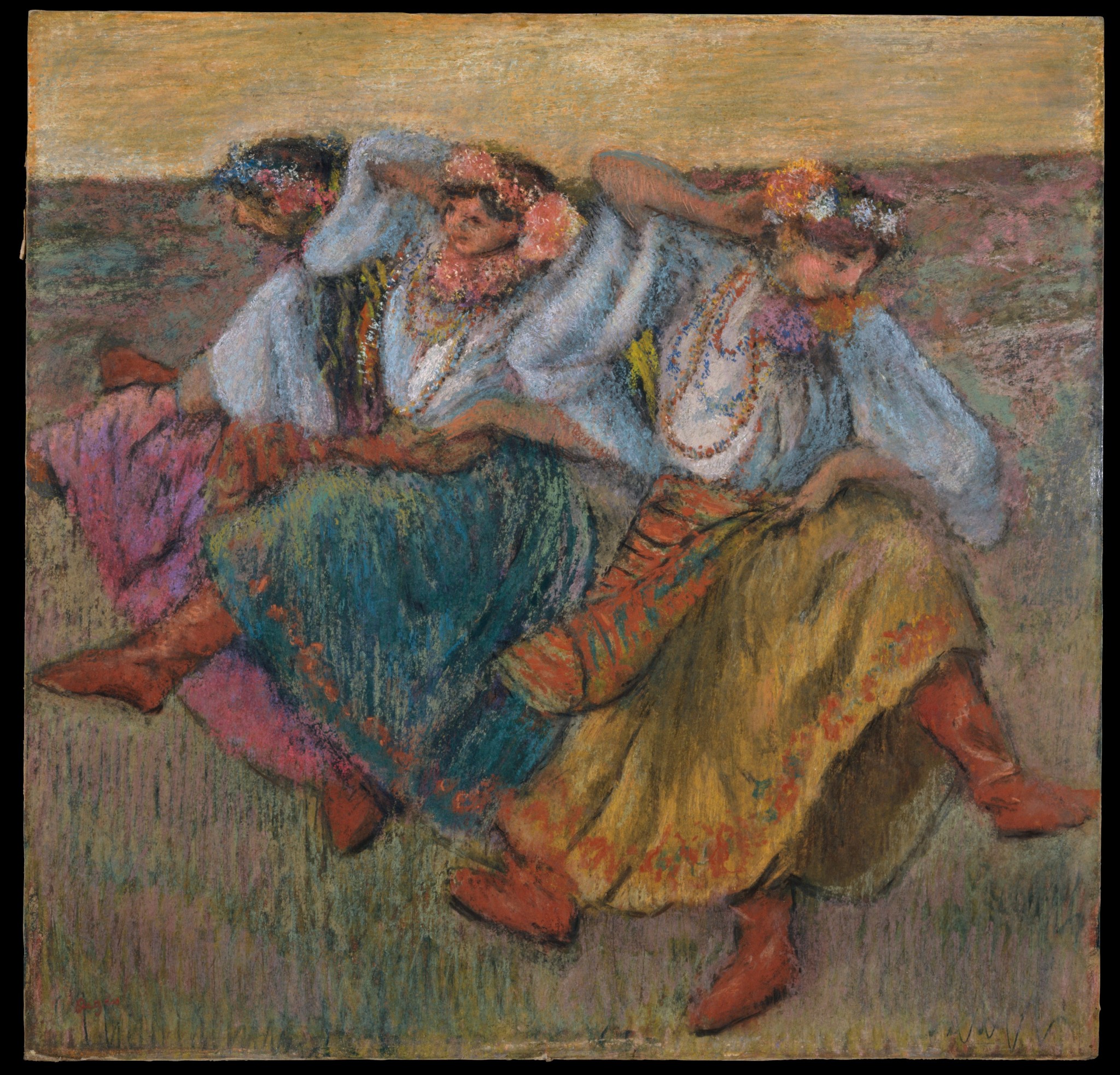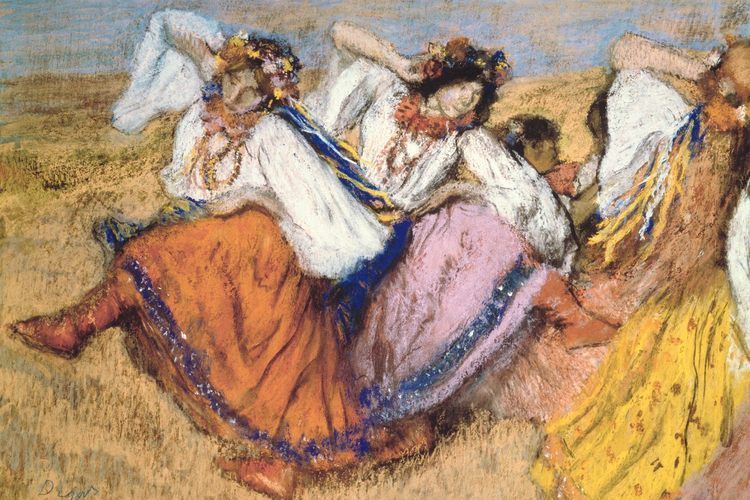Impressionism in a 19th century art movement that originated in Paris. It was considered radical at the time it appeared; vivid colours and sketch like appearance of the paintings was something completely new to the audience who was accustomed to more somber paintings exhibited at the Salon.

Edgar Degas (19 July 1834 – 27 September 1917)
PAINTING STYLE:
– asymmetrical composition (influence of Japonism)
– his portraits are known for their portrayal of human isolation and their psychological complexity
– off-center compositions, experiments with color and form
– his painting style shows admiration for the old masters and his admiration for Jean Auguste Dominique Ingres and Eugene Delacroix
– sense of movement is evident in his paintings
– ‘rich-colored realism’
PAINTING SUBJECTS: ballerinas, dancers, nudes, Parisian cafe scenes
FAMOUS WORKS:
The Bellelli family
Woman in the Bath
Stage Rehearsal
L’Absinthe
INTERESTING FACTS: he believed that ‘the artist must live alone, and his private life must remain unknown‘.
– known for his often cruel wit

Edouard Manet (23 January 1832 – 30 April 1883)
PAINTING STYLE:
-black outlining of figures (his work is considered as ‘early modern’)
– roughly painted style and photographic lighting
– composition reveals his study of the old masters such as Giorgione, Titian, Velazquez and Goya
– flatness; inspired by Japanese woodblock prints
PAINTING SUBJECTS: cafe scenes, paintings of social activities, Paris street scenes
FAMOUS WORKS:
The Luncheon on the Grass (1863.)
Olympia (1863.)
Young Flautist (1866.)
Music in the Tuileries (1862.)
The Railway (1872.)
INTERESTING FACTS:
– he often used Victorien Meuret as a model
– married his piano teacher, a Dutch lady Suzanne Leenhoff whom he used as a model as well

Claude Monet (14 November 1840 – 5 December 1926)
PAINTING STYLE:
– he used bright colours in dabs and dashes and squiggles of paint
– by painting landscapes he tried to capture the changing of light and the passing of the seasons
– he studied the effects of atmosphere
– due to his bad eye sight near the end of his life, he started painting with dots
PAINTING SUBJECTS: gardens and water lilies, women in garden or outdoors, river and boats, Rouen cathedral
FAMOUS WORKS:
Impression, Sunrise
Rouen Cathedral Series
London Parlament Series
Water lilies
INTERESTING FACTS:
– had a large family and married two times

Pierre-Auguste Renoir (25 February 1841 – 3 December 1919)
PAINTING STYLE:
– vibrant light and saturated colour
– warm sensuality
– through freely brushed touches of color, figures softly fuse with one another and their surroundings
– he admired the 18th century master Francois Boucher, as well as Raphael and Renaissance masters
PAINTING SUBJECTS: focus on people in intimate and candid compositions, female nude
FAMOUS WORKS:
Luncheon of the Boating Party (1880.)
Nude (1910.)
Bal du moulin de la Galette (1876.)
The Theatre Box (1874.)
Two Sisters (1881.)

Berthe Morisot (January 14, 1841 – March 2, 1895)
PAINTING STYLE:
– She worked in oil paint, watercolor, pastel, and produced sketches
– sense of space and depth through the use of color
– used white expansively in her paintings
– influenced by the color and expressive, confident brushwork of Fragonard
PAINTING SUBJECTS: domestic life and portraits in which she could use family and personal friends as models, including her daughter Julie, landscapes, portraits, garden settings and boating scenes, later nudes (avoided urban and street scenes)
– Her paintings reflect the 19th-century cultural restrictions of her class and gender
FAMOUS WORKS:
The Cradle (1872.)
Lady at her Toilette (1875.)
Reading (1873.)
INTERESTING FACTS:
– she was married to Edouard Manet’s brother Eugene with whom she had a daughter Julie
– she was the one who introduced plein-air technique to Manet, after Corot had shared it with her

Mary Cassatt (May 22, 1844 – June 14, 1926)
PAINTING STYLE:
– while in Italy she studied works of Correggio and Parmigianino
– Under the influence of Impressionist, Cassatt revised her technique, composition, and use of color and light, manifesting her admiration for the works of the French savant garde, especially Degas and Manet
– soft colour palette and light backgrounds
PAINTING SUBJECTS: domestic life, portraits, mother-and-child subjects, opera scenes
FAMOUS WORKS:
Woman with a Pearl Necklace in a Loge (1879.)
In the Box (1879)
Self-portrait (1878.)
INTERESTING FACTS:
– she admired Degas and his pastels had left a deep impression on her
– she was very close with Degas and they shared similar tastes in art, music and literature, they had studied painting in Italy, came from affluent backgrounds, were independent and never married

Gustave Caillebotte (19 August 1848 – 21 February 1894)
PAINTING STYLE:
– he painted in more realistic manner then the rest of the gruop
– influenced by Japanese prints and photography
– intense interest in perspective effects
– he used a soft impressionistic technique reminiscent of Renoir to convey the tranquil nature of the countryside, in sharp contrast to the flatter, smoother strokes of his urban paintings
PAINTING SUBJECTS: domestic and familial scenes, interiors, and portraits, urban Paris, still life paintings
FAMOUS WORKS:
Les raboteurs de parquet (1875.)
Paris Street, Rainy Day (1877.)
Rue Halévy, From the 6th Floor (1878.)
Nude Lying on a Couch (1873.)
INTERESTING FACTS:
– in addition to painting, he had many other interests including stamp collecting, orchid growing, yacht building and even textile design
– he was also a patron of art and an art collector

Camille Pissarro (10 July 1830 – 13 November 1903)
PAINTING STYLE:
– The manner of painting was too sketchy and looked incomplete
– visible and expressive brushwork
– shadows painted in colour, rather than black or brown
– By the 1880s, Pissarro began to explore new themes and methods of painting – Neo-Impressionsm
– Pointillism (along with Seurat)
PAINTING SUBJECTS: mostly landscapes scenes, natural outdoor setting
FAMOUS WORKS:
Boulevard Montmartre la nuit (1898.)
La Place due Théâtre Français (1898.)
Boulevard Montmartre à Paris (1897.)
Un Carrefour à l’Hermitage, Pontoise (1876.)
Tags: Art profiles, Berthe Morisot, Camille Pissarro, Claude Monet, Edgar Degas, Edouard Manet, Gustave Caillebotte, Impressionism, Mary Cassatt, painting style, Pierre-Auguste Renoir
 Edgar Degas, Rest, 1893, pastel
Edgar Degas, Rest, 1893, pastel





































